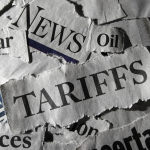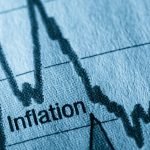Maintaining stable inflation is a crucial aspect of monetary policy for several reasons, each with far-reaching implications for economies, businesses, and individuals.
So what is inflation? Inflation is the rate at which the general level of prices for goods and services is rising and it plays a pivotal role in shaping economic decisions and outcomes. Put simply, the price that you paid for your groceries last year might have been $200 and this year for the same items it now costs $220.
Here, I’ll delve into the significance of keeping inflation in check over time.
Price Stability and Economic Growth:
Inflation stability fosters economic growth by providing certainty and predictability to businesses and consumers.
When inflation is low and stable, individuals and businesses can make long-term financial plans with greater confidence. It helps to reduces uncertainty about future prices, which encourages investment, consumption, and overall economic activity.
Conversely, high and volatile inflation can disrupt economic decision-making, leading to misallocation of resources and hindering growth. Individuals and businesses are more cautious about spending when inflation is high.
Maintaining Purchasing Power:
One of the primary concerns with high inflation is its erosion of purchasing power. What this means is that when prices rise rapidly, the value of money declines, leading to a situation where individuals can buy fewer goods and services with the same amount of money.
This diminishes the standard of living, particularly for those on fixed incomes, such as retirees or individuals with savings.
By keeping inflation low and stable, central banks aim to preserve the purchasing power of money, ensuring that wages and savings retain their value over time.
Wage and Price Expectations:
Inflation expectations influence wage and price-setting behaviour. For example, if individuals and businesses expect prices to rise rapidly in the future, they may demand higher wages and raise prices pre-emptively. Employees want higher income to be able to afford goods and businesses wanting to retain their employees then have no choice to increase the costs of their goods to cover the additional wage cost and this then fuels a self-perpetuating cycle of inflation.
Conversely, when inflation expectations are anchored at low levels, it helps maintain wage and price stability, contributing to overall economic stability.
Interest Rates and Investment:
Central banks use interest rates as a tool to control inflation. By adjusting interest rates, central banks can influence borrowing and spending behavior in the economy.
When inflation is high, central banks typically raise interest rates to curb spending and reduce inflationary pressures. The idea of this is that when less people are spending the price of goods decreases as businesses have an oversupply of products that they need to sell.
Conversely, in periods of low inflation or deflation, central banks may lower interest rates to stimulate economic activity.
Stable inflation allows central banks to set interest rates at levels conducive to sustainable economic growth without the need for drastic adjustments that could disrupt financial markets.
International Competitiveness:
Inflation affects a country’s international competitiveness by influencing its exchange rate.
High inflation rates relative to trading partners can lead to a depreciation of the currency, making exports more competitive but imports more expensive.
Conversely, low and stable inflation contributes to exchange rate stability, enhancing certainty for exporters and importers and promoting international trade.
Debt Management:
Inflation can affect the real value of debt. Moderate inflation can help reduce the burden of debt over time by eroding its real value. This is particularly relevant for governments with high levels of debt, as long as inflation remains within manageable levels.
However, high inflation rates can also lead to higher nominal interest rates, increasing the cost of servicing debt and potentially destabilizing government finances.
Economic Stability:
Inflation stability is closely linked to broader economic stability. High and volatile inflation can lead to economic distortions, such as resource misallocation, income redistribution, and reduced investment.
These distortions can undermine long-term economic growth and contribute to social unrest. Conversely, low and stable inflation supports a more balanced and sustainable economic environment, reducing the likelihood of severe economic downturns and promoting social cohesion.
Conclusion:
In conclusion, maintaining inflation stability is essential for fostering sustainable economic growth, preserving purchasing power, anchoring expectations, facilitating investment, promoting international competitiveness, managing debt, and ensuring economic stability.
Central banks play a pivotal role in achieving and maintaining price stability through monetary policy tools such as interest rate adjustments and forward guidance. By carefully managing inflation, policymakers can support a conducive environment for long-term prosperity and well-being.
How is inflation reduced?
Inflation is reduced by central banks increasing interest rates.
If consumers are faced with higher interest rates that will mean less income that they have available for expenditure due to now having to make higher mortgage repayments.
This reduced expenditure in turn slows the economy. How does it do this?
Demand for goods will slow. Thinking about what we mentioned earlier around how prices decrease and relate to this a retail shop like XYZ Books. Because consumers aren’t spending money on discretionary items there is then less demand for books that XYZ stocks on the shelves.
As XYZ aren’t seeing a high demand for their books, they then don’t need as many employees to sell them, this then slows wages growth.
From here, businesses like XYZ have to move their books so they start to lower prices to encourage more people to spend again, this in turn has the effect of easing inflation rates over time.
Issues:
This potential issue with central banks increasing their interest rates are, what if households are now comfortable living with more debt as they are used to having high mortgages due to the increasing property prices?
They then don’t slow their expenditure, the economy does not slow at that then forces central banks to continually keep increasing their interest rates even higher.
Alternatively, what if people just don’t spend money as they want to save their cash funds? This will also have the same effect.
There is also the mentality around FOMO: Fear of Missing Out! Do consumers think well rates will decrease soon so I better just buy now? The problem with this is, what if rates do not decrease soon
Retirees
They tend not to be the ones that have debt.
When interest rates rise retirees are now earning more on their cash and savings and should feel wealthier. BUT the cost of everything is increasing so that erodes that feeling.
Then what happens when rates decrease but the costs do not go back down? You have a lifestyle devaluation, and this is enough of an issue for retirees.
The problem walking in the door and yes, you are related to it…
“We need to access some of our super or investments to help the kids as their costs of servicing their debts has gone up”!!!
Hopefully this is not the conversation in your house, but people are having this in theirs, I know this as they are asking me.
Now their problem wants to become your problem…
In all the real estate hype did the kids feel they better not miss out and they thought they would borrow more and buy that more expensive home? Yes, you told them about the double-digit interest rates you paid and they thought you were crazy, well crazy is here.
- How will they afford the repayments?
- How will they ever repay the capital amount?
Heaven, forbid they have to have less diners or reduce their lifestyle.
Now I know I sound harsh here…
But
I look after retirees and sadly I am seeing this more often than not.
You raised the kids and made it through all these cycles and the kids want to simply ask you to pick up the bill… again (I’m sure asked in a very nice way!!) and unfortunately there is no easy answer.
The problem is that after Covid the cost of houses in Australia and around the world went crazy.
How on earth does anyone that did not own a house before this time ever afford one?
How on earth do they ever repay the loan?
This is a massive problem and I feel for the next generation of house owners coming through.
It all goes back to inflation…
When the cost of everything increases then then wages go up, then people have more they want to spend. More people are happy to spend and they want to upgrade their lifestyle and we are now seeing generations coming through living in a very materialistic/disposal world where there is pressures to keep up with the Joneses. When governments continue spending on ongoing infrastructure and government expenditure it places wage pressure on the rest of the economy. That then pushes up inflation.
Now everyone is somehow agreeing to spend more and increase the amount of capital they have locked up in property. They are all agreeing to higher debt without actually having a conversation. It is like the frog in the pot.
Financial Advice is sometimes about not getting into the pot or reducing the size of the pot so the problem is not as big.
I do not have the magic wand to fix this. I can say we have helped the families that are our clients to try and avoid this.
While having your home go up in value feels good, at what cost does this have to us all in the long term?
Counter Argument:
There will be stories of property where those that bought made a huge gain, but we are now having people selling at a loss. That is the start of the unravelling process as the costs of living continues and the longer rates stay high then the cash buffers that households had continues to erode.
Those that own their home, have investments and a sensible sustainable lifestyle will get through this period just fine. BUT some are now getting the squeeze from the generation below.
We are in interesting times. We need State and Federal governments to recognise the role they are playing in fuelling inflation.
As Australians we want to afford a home and have a happy and affordable life AND naturally we want that for our kids as well.
Need an intro to lead into the following two topics and why you’re talking about this
Some examples of when inflation turns to Hyperinflation
Certainly, hyperinflationary episodes have occurred throughout history, wreaking havoc on economies and societies. Here are five examples of countries where inflation spiralled out of control:
1. Germany (1920s):
Perhaps the most infamous case of hyperinflation, Germany’s experienced a catastrophic inflationary episode in the early 1920s. Following World War I, the German government faced enormous reparation payments and resorted to printing vast quantities of money to meet its obligations. The result was hyperinflation, with prices doubling every few days. At its peak in November 1923, prices were doubling every few hours, wiping out savings and causing widespread social upheaval. The value of the German mark plummeted, and people resorted to using alternative currencies or bartering for goods.
2. Zimbabwe (2000s):
In the early 2000s, Zimbabwe underwent a period of hyperinflation that ranks among the worst in modern history. The crisis was fuelled by a combination of factors, including economic mismanagement, political instability, and land reform policies. The government’s response to fiscal deficits was to print money indiscriminately, leading to hyperinflationary pressures. At its peak in 2008, Zimbabwe’s inflation rate soared to astronomical levels, reaching an estimated annual rate of several billion percent. The Zimbabwean dollar became virtually worthless, and the economy collapsed, leading to severe shortages of goods and widespread poverty.
3. Venezuela (2010s):
Venezuela’s economy experienced a rapid descent into hyperinflation during the 2010s, driven by a combination of economic mismanagement, declining oil prices, and political turmoil. The government’s heavy reliance on oil revenues, coupled with extensive social welfare programs and currency controls, led to fiscal imbalances and a severe shortage of foreign currency. In response, the government resorted to printing money to finance its spending, exacerbating inflationary pressures. By 2018, Venezuela’s inflation rate had soared to over one million percent, leading to acute shortages of food, medicine, and basic goods. The hyperinflationary crisis precipitated a deep economic recession and triggered a mass exodus of Venezuelans seeking refuge abroad.
4. Hungary (1940s):
After World War II, Hungary experienced one of the most severe hyperinflationary episodes in history. The Hungarian pengő collapsed in value as the government attempted to finance its wartime expenditures by printing money. Hyperinflation reached its peak in July 1946, with prices doubling every 15 hours. The currency became virtually worthless, and people resorted to bartering for goods. The hyperinflationary crisis exacerbated social unrest and political instability, contributing to the eventual establishment of a communist regime in Hungary.
5. Yugoslavia (1990s):
During the breakup of Yugoslavia in the early 1990s, several successor states experienced hyperinflationary crises. One of the most notable cases was in Serbia, where hyperinflation reached its peak in January 1994. The Yugoslav dinar became virtually worthless, with prices doubling every few days. The collapse of the currency undermined confidence in the government and exacerbated social tensions. The hyperinflationary crisis contributed to the disintegration of the Yugoslav federation and prolonged economic hardship in the region.
Hyperinflation Conclusion:
These examples underscore the devastating consequences of hyperinflation on economies and societies. Hyperinflation erodes the value of money, wipes out savings, undermines confidence in the government, and exacerbates social unrest. Preventing and controlling hyperinflation requires sound macroeconomic policies, including fiscal discipline, prudent monetary management, and structural reforms. By learning from past mistakes and implementing sound economic policies, countries can avoid the ravages of hyperinflation and promote sustainable economic growth and development.
Beware Stagflation:
Stagflation, a phenomenon characterized by stagnant economic growth alongside high inflation and high unemployment, poses significant challenges for policymakers and can have severe repercussions for economies and individuals alike. Here’s why stagflation is so concerning:
1. Economic Stagnation:
Stagflation represents a combination of stagnant economic growth and rising prices, creating a dilemma for policymakers. Typically, periods of high inflation coincide with robust economic activity, driven by increased demand and expansionary monetary policies. However, in stagflationary environments, economic growth stagnates or even contracts while inflation remains elevated. This stagnation hampers job creation, impedes investment, and reduces productivity, leading to prolonged economic malaise.
2. Policy Dilemma:
Stagflation presents policymakers with a challenging dilemma. Traditional monetary policy tools aimed at stimulating economic growth, such as lowering interest rates or increasing money supply, can exacerbate inflationary pressures. Conversely, policies designed to curb inflation, such as raising interest rates or tightening monetary policy, may further suppress economic activity and exacerbate unemployment. This policy trade-off complicates efforts to address stagflation effectively, as measures to tackle one aspect of the phenomenon may worsen the other.
3. Reduced Purchasing Power:
High inflation erodes the purchasing power of money, diminishing the standard of living for households and reducing their real incomes. As prices rise faster than wages, consumers find their budgets stretched thinner, leading to a decline in purchasing power. This reduction in purchasing power can lead to a decline in consumer confidence and spending, further dampening economic activity. Stagflation exacerbates this problem by combining stagnant growth with high inflation, resulting in a prolonged period of reduced purchasing power and economic hardship for households.
4. Unemployment:
Stagflation is often accompanied by high unemployment rates, compounding the economic challenges faced by individuals and communities. In stagnant or contracting economies, businesses may reduce hiring or implement layoffs to cut costs and remain competitive. Additionally, high inflation can lead to wage-price spirals, where workers demand higher wages to keep pace with rising prices, further squeezing business profitability and leading to job losses. Persistently high unemployment rates can have long-term social and economic consequences, including poverty, inequality, and social unrest.
5. Business Uncertainty:
Stagflation contributes to increased uncertainty for businesses, making it difficult for them to plan and invest for the future. Uncertainty about future inflation rates, economic growth prospects, and government policies can deter business investment, leading to reduced capital expenditures and innovation. Businesses may adopt a cautious approach, delaying expansion plans or reducing investment in research and development until economic conditions improve. This uncertainty can prolong the stagnation phase of stagflation and impede the economy’s ability to recover.
Stagflation Conclusion:
Stagflation represents a challenging economic environment characterized by stagnant growth, high inflation, and elevated unemployment. It presents policymakers with a difficult policy dilemma, as traditional monetary and fiscal policy tools may be ineffective or counterproductive in addressing both inflation and unemployment simultaneously. Stagflation reduces purchasing power, exacerbates unemployment, increases business uncertainty, and prolongs economic hardship for individuals and communities. Effectively addressing stagflation requires a coordinated policy response that balances the need to control inflation with measures to stimulate economic growth and job creation.
Ask Troy a Question.
Simply fill in the below form with your question and we will get back to you shortly.
















